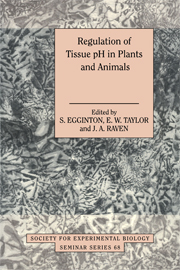Book contents
- Frontmatter
- Contents
- List of contributors
- Preface
- Measurement of intracellular pH: a comparison between ion-sensitive microelectrodes and fluorescent dyes
- pH-sensitive microelectrodes: how to use them in plant cells
- The use of nuclear magnetic resonance for examining pH in living systems
- Invasive studies of intracellular acid–base parameters: quantitative analyses during environmental and functional stress
- Lactate, H+ and ammonia transport and distribution in rainbow trout white muscle after exhaustive exercise
- Limiting factors for acid–base regulation in fish: branchial transfer capacity versus diffusive loss of acid–base relevant ions
- H+-mediated control of ion channels in guard cells of higher plants
- pH regulation of plants with CO2-concentrating mechanisms
- Intracellular pH regulation in plants under anoxia
- The role of turtle shell in acid–base buffering
- Acid–base regulation in crustaceans: the role of bicarbonate ions
- A novel role for the gut of seawater teleosts in acid–base balance
- pH and smooth muscle: regulation and functional effects
- Regulation of pH in vertebrate red blood cells
- Acid–base regulation in hibernation and aestivation
- Hepatic metabolism and pH in starvation and refeeding
- Back to basics: a plea for a fundamental reappraisal of the representation of acidity and basicity in biological solutions
- Index
Acid–base regulation in hibernation and aestivation
Published online by Cambridge University Press: 22 August 2009
- Frontmatter
- Contents
- List of contributors
- Preface
- Measurement of intracellular pH: a comparison between ion-sensitive microelectrodes and fluorescent dyes
- pH-sensitive microelectrodes: how to use them in plant cells
- The use of nuclear magnetic resonance for examining pH in living systems
- Invasive studies of intracellular acid–base parameters: quantitative analyses during environmental and functional stress
- Lactate, H+ and ammonia transport and distribution in rainbow trout white muscle after exhaustive exercise
- Limiting factors for acid–base regulation in fish: branchial transfer capacity versus diffusive loss of acid–base relevant ions
- H+-mediated control of ion channels in guard cells of higher plants
- pH regulation of plants with CO2-concentrating mechanisms
- Intracellular pH regulation in plants under anoxia
- The role of turtle shell in acid–base buffering
- Acid–base regulation in crustaceans: the role of bicarbonate ions
- A novel role for the gut of seawater teleosts in acid–base balance
- pH and smooth muscle: regulation and functional effects
- Regulation of pH in vertebrate red blood cells
- Acid–base regulation in hibernation and aestivation
- Hepatic metabolism and pH in starvation and refeeding
- Back to basics: a plea for a fundamental reappraisal of the representation of acidity and basicity in biological solutions
- Index
Summary
Introduction: from water to air breathing
Transition from water to land has freed animals from the constraints of water breathing: due to the low O2 concentration in water, a waterbreather is obliged to achieve a high ventilatory flow rate of a medium with a high capacitance both for CO2 and for heat (Dejours, 1981). The animal thus has very little control over any of these. By contrast, the high O2 concentration in air has enabled PCO2 to be set at a higher level and air-breathers can therefore partly devote the ventilatory system to its control. Two major benefits accrue from this in terms of acid–base regulation. The first is a much higher open system CO2 buffer value, and thereby a more efficient ventilatory control of pH (this buffer value is proportional to PCO2 at a given pH). The second stems from the high diffusivity of CO2. Krogh's diffusion coefficient for CO2 in frog muscle at 21°C is 37-fold higher than the same coefficient for O2 (Dejours, 1981). In a mammal breathing air at sea level, the maximal possible PO2 difference between arterial blood and mitochondria is 13.3 kPa. The corresponding difference for CO2 is 0.36 kPa, less than 7 per cent of arterial PCO2. This percentage would be much higher in a waterbreather. As a consequence, the ventilatory control sets the value of PCO2, not only in the arterial blood, but in all intracellular compartments (except for a few ill-perfused areas in which CO2 may accumulate).
- Type
- Chapter
- Information
- Regulation of Tissue pH in Plants and AnimalsA Reappraisal of Current Techniques, pp. 323 - 340Publisher: Cambridge University PressPrint publication year: 1999
- 2
- Cited by



